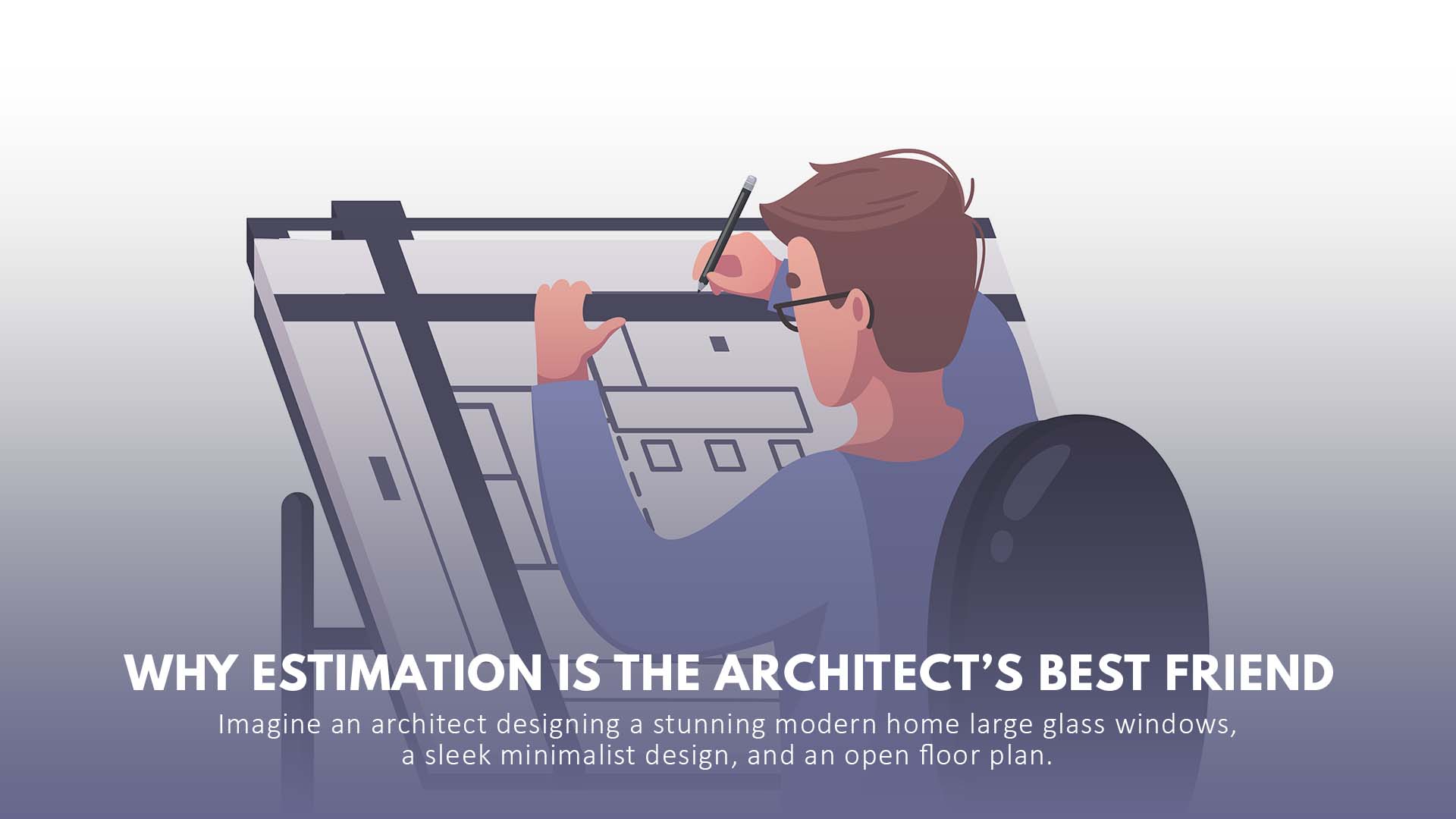Imagine an architect designing a stunning modern home large glass windows, a sleek minimalist design, and an open floor plan. The vision is clear, but then reality strikes. Will the budget allow for such an ambitious design? Will material costs stay within limits? Can the project meet deadlines without financial surprises?
This is where cost estimation becomes an architect’s best friend. Construction cost estimation services ensure that a project moves from a dream to reality without unexpected financial obstacles. When architects and estimators work together, they create a balance between design ambition and financial feasibility, ensuring smooth execution from blueprint to construction. In this article, we’ll explore why cost estimation is essential in architecture, the common mistakes that lead to budget overruns, and how the collaboration between architects and estimators leads to successful projects.

The Role of Estimators in Construction Projects
An estimator is like the financial navigator of a construction project. Their job is to analyze material costs, labor expenses, equipment needs, and potential risks to provide an accurate cost projection. Without a detailed estimate, even the most brilliant architectural designs can run into serious financial trouble.
Here’s how the construction estimation process works:
- Initial Cost Assessment – Before an architect finalizes a design, the estimator provides an early cost analysis based on initial sketches.
- Detailed Estimations – Once the design is refined, estimators create a more detailed cost breakdown, factoring in materials, labor, and logistics.
- Ongoing Adjustments – As the project progresses, estimators update the cost projections to adapt to market fluctuations or design modifications.
By working closely with estimators, architects can avoid financial pitfalls and design within realistic cost boundaries.
Why Cost Estimation Is Critical in Architecture
Architectural projects don’t just involve creativity; they require careful budgeting. The importance of cost estimation in architecture cannot be overstated. Here’s why:
- Prevents Budget Overruns – Without proper cost estimation, projects often exceed initial budgets, leading to delays or incomplete structures.
- Ensures Feasibility – No matter how visionary a design is, it must be financially achievable. Estimators help architects align their vision with real-world financial constraints.
- Improves Client Trust – When clients receive an accurate cost breakdown from the start, they are more likely to feel confident about the project.
- Enhances Efficiency – A well-estimated project experiences fewer interruptions due to unexpected expenses, ensuring smoother execution.
By integrating architectural cost planning services, architects can develop cost-effective designs without compromising creativity.
Common Estimating Mistakes Architects Make
Even the most experienced architects can fall into some common estimating pitfalls:
- Underestimating Material Costs – Prices of construction materials fluctuate, and failing to account for these changes can lead to significant cost overruns.
- Ignoring Labor Expenses – Labor costs vary based on region, project complexity, and workforce availability. Estimators ensure this factor is accurately calculated.
- Overlooking Hidden Costs – Permits, insurance, and unexpected site conditions can add up quickly if not considered in the initial estimate.
- Not Using the Right Estimating Tools – Relying on outdated methods instead of modern best estimating software for architects can lead to errors.
- Failing to Consult Professional Estimators – Some architects attempt to handle cost estimation themselves, but hiring an expert can save time and money.
To avoid these mistakes, architects should always consider working with top estimating firms for architects that specialize in balancing design and cost efficiency.
Also Read: How to Avoid Common Mistakes in Construction Cost Estimating
How to Avoid Cost Overruns in Architecture
Budget overruns can turn a promising project into a financial nightmare. Here’s how architects and estimators can prevent them:
1. Use Accurate Cost Estimation Software
The right tools make all the difference. Cost estimation software comparison shows that modern digital solutions can improve accuracy by analyzing real-time material costs, labor rates, and inflation trends.
2. Hire a Professional Estimator
If budget constraints or time limitations prevent an architect from conducting thorough cost analysis, the best option is to hire a construction estimator. Their expertise ensures that every cost factor is considered.
3. Conduct a Risk Analysis
Unexpected issues like supply chain disruptions or sudden labor shortages can derail a project. Factoring in a risk buffer helps architects and contractors stay prepared.
4. Maintain Clear Communication Between Teams
Strong collaboration between architects, estimators, and contractors ensures that cost adjustments are made before they become problems. Contractor estimating services help streamline the budgeting and execution phases.
5. Focus on Value Engineering
Instead of cutting corners, estimating vs. value engineering in construction focuses on finding cost-effective solutions that maintain design quality. For example, choosing alternative materials or adjusting design features to reduce costs without sacrificing aesthetics.
By following these strategies, architects can execute projects smoothly while staying within budget.
The Best Architectural Estimating Tools
Technology plays a key role in modern cost estimation. Some of the best tools for architects and estimators include:
- ProEst – A cloud-based tool that simplifies construction estimating vs. architectural budgeting
- PlanSwift – Ideal for material takeoffs and accurate budgeting
- Stack – Helps with project collaboration and estimating materials
- RSMeans Data Online – Provides real-time cost data for different regions
- Bluebeam Revu – A powerful tool for project planning and budgeting
These tools enhance efficiency and accuracy, making cost estimation more reliable.
Benefits of Working with a Professional Estimator
Some architects try to handle cost estimation themselves, but working with a dedicated estimator offers significant advantages:
- Accuracy – Professional estimators use specialized software and real-world data to provide precise cost breakdowns.
- Time-Saving – Architects can focus on design while estimators handle the financial details.
- Risk Reduction – With expert estimators, the chances of financial surprises are minimized.
- Better Negotiations – Estimators help architects and clients negotiate better deals with contractors and suppliers.
If you’re looking for experts, searching for a building cost estimator near me can connect you with local professionals who understand regional pricing trends.
Also Read: Common Challenges in Material Takeoff and How to Overcome Them
Conclusion
The partnership between architects and estimators is the key to successful, cost-efficient projects. With proper estimation techniques, advanced software, and expert collaboration, architects can create stunning designs without financial setbacks.
By integrating architectural budgeting best practices and using the right construction cost estimation services, architects can turn ambitious visions into reality on time and within budget.
